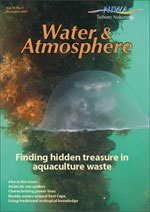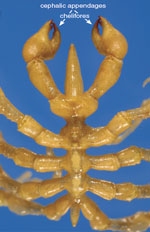PDF of this article (313 KB)





By digging into the DNA of sea spiders brought back from BioRoss 2004, Johanna Nielsen, Anne-Nina Lörz, and Shane Lavery have been able to shed new light on the creatures’ evolutionary background.
When RV Tangaroa headed south for BioRoss 2004,one of the main objectives of the voyage was to study the biodiversity of marine communities of the northern Victoria Land coast and the Balleny Islands. Among other discoveries, NIWA scientists found a great diversity of sea spiders. Three years on, our genetic analyses of the specimens from this voyage are influencing a revised view of the sea spider group’s evolutionary development, or phylogenetics.
‘Sea’ spider?
Sea spiders, or pycnogonids, are a unique group of marine arthropods found in oceans around the globe. They vary in morphology (shape) and size, ranging from tiny species a few millimetres long to giant species, from the aptly named Colossendeidae family, that can have leg spans up to 70 cm.
They share a number of traits that clearly define them as a related group. These include a small abdomen and prominent proboscis (elongated head part) – which often leads to confusion between the anterior (front) and posterior (rear) ends of their body.
Most pycnogonid species have eight legs, hence their common name – sea spiders – but it is primarily their three pairs of ‘cephalic appendages’ that exclude them from being classified as true spiders. Cephalic appendages are limbs coming off the head end of the body; these appendages aren’t made for walking, but instead serve for sensing and cleaning (palps), feeding and defence (chelifores), and reproducing (ovigers).
Biodiversity in the Antarctic
Antarctic pycnogonids make up approximately 40% of the 80 genera worldwide and 22% of the more than 1300 described species. This great diversity of species in the Antarctic supports suggestions that the region may be a centre of evolution of sea spider species.
During the BioRoss 2004 survey, NIWA scientists collected approximately 2220 individual pycnogonids. We identified thespecimens using published keys and the specimens in NIWA’s invertebrate collection (NIC). The BioRoss sea spiders are now all cataloged in the NIWA Specify database and represent a significant taxonomic resource. In total, the BioRoss 2004 collection has 18 species representing 10 genera and five of the eight known pycnogonid families. These include three species with more than four pairs of legs and several taxa new to the national collection.
The majority of the BioRoss 2004 specimens were stored directly in ethanol. This preservation method let us extract high-quality DNA samples for detailed molecular studies of phylogenetic relationships.
Revising our view of the family tree
First we extracted DNA from 32 BioRoss 2004 specimens including 21 different species from each of the five different families. We compared the DNA with that from published reports about other pycnogonids and a range of different arthropod species. Then we examined the evolutionary relationships among these species by reconstructing phylogenetic trees.
Although the interfamilial relationship of the pycnogonids is uncertain, one of the most enduring evolutionary hypotheses is that there is a trend toward reduction in the number and complexity of cephalic appendages. Results from our study did not support the hypothesis among families and even suggested that the trend may be reversed.
One additional unexpected finding also resulted from this molecular study. Each of the phylogenetic trees showed strong support for the current family classifications – with one exception. Austropallene cornigera is an Antarctic species which has always been problematic to place within the phylogeny due to its complete lack of palps, uniquely shaped proboscis, and ‘swollen’ chelifores. It is currently considered a member of the Callipallenidae family. Each of the reconstructed trees in this study consistently placed Austropallene cornigera at the base of the Nymphonidae family. This provides further evidence for refuting the cephalic appendage hypothesis as it would imply that palps developed separately in the Nymphonidae family.
Our phylogenetic study of sea spiders has generated new taxonomic and molecular data and has also addressed a long-standing hypothesis on the evolution of the entire group of these fascinating organisms. Though the scientific community is still undecided on some aspects of sea-spider classification, the BioRoss 2004 collection is a considerable contribution to the field of pycnogonid taxonomy.
Tangaroa will soon head south again, January–March 2008. During the International Polar Year (IPY) expedition, instigated by the Census of Marine Life, scientists will survey biodiversity patterns in previously unsampled areas of the Ross Sea. We will deploy different types of gear to collect biological samples from the shelf to the abyss (from about 400 to 3500 m depth). We can look forward to many more specimens to add to the NIC and to further our exploration of the evolution and biodiversity of Antarctic sea spiders.
NIWA’s Invertebrate Collection: a treasure chest of additional samples
Although archival organisms are a wonderful taxonomic resource, many older samples have been fixed initially in formalin, which eventually degrades DNA. Despite this, we’ve recently obtained data from NIC archival sea spiders using a modified DNA extraction method. This new data includes species from the remaining three pycnogonid families which will increase the taxonomic coverage of these datasets. This successful extraction of DNA from formalin-fixed samples is encouraging and further endorses the NIC as an important resource for taxonomic and molecular data.
The scoop on sea spiders
- Pycnogonids, or sea spiders, are found throughout the world; the Antarctic is especially species-rich.
- 2220 specimens collected during the BioRoss 2004 voyage have been classified.
- DNA analysis is revealing new information about the evolutionary relationships of different sea spider families.
Johanna Nielsen recently completed her BSc (Hons) dissertation entitled ‘The molecular phylogenetics of Antarctic sea spiders (Pycnogonida)’ at Auckland University under the supervision of Dr Anne-Nina Lörz and Dr Shane Lavery. Anne-Nina is project leader of the NIWA Invertebrate Collection in Wellington and Shane is a senior lecturer at Auckland University.
Teachers’ resource for NCEA Achievement Standards or Unit Standards: Biology Level 2 US6308, Level 3 AS90718
